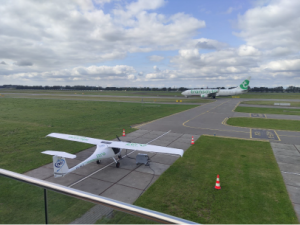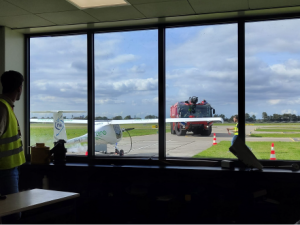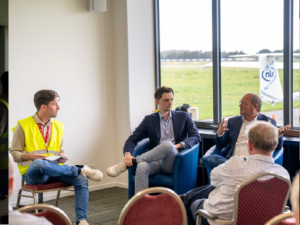
TULIPS DEMO DAY
Share news
On 17 September 2024, TULIPS hosted a groundbreaking Demo Day at Rotterdam The Hague Airport, showcasing innovations in unattended charging for electric aircraft. The event was attended by Jens van den Berg from NAG, who represented the strengthening ecosystem project, which promotes collaboration to accelerate sustainable aviation in the Netherlands.
The TULIPS demo was an interesting presentation and proof of concept that was related to unattended “refueling” (recharging) of electric aircraft.
The demonstrator was the NLR Pipistrel at the RAC (Rotterdamse Aero Club) at Rotterdam The Hague Airport.

The system demonstrated by Tibor van Steenis showed off potential future wireless power-off capabilities for the Pipistrel charging system. A dashboard with several parameters was shown with live data from the aircraft being broadcast via Wi-Fi to a screen in the conference room.
The first demo showed the remote data viewing capabilities of the prototype system and the manual remote shut-off. This system is an improvement on the existing safety protocols that were also shared during the presentations. The current protocols suggest first walking towards the burning aircraft to shut down the charging process.
This can now be done remotely, and thus also more safely.
The second demo of this system was the automatic remote shut-off of the charging process. Tibor emulated the internal aircraft system on his laptop and manually created various fault codes such as battery cell overheating and overvoltage. The system showed the error on the dashboard and shut-down the charging process on its own.

This then aligned very well with the second presenters, Freek Vermeulen and Ijsbrand Kruithof from Bosch who came to demo their camera-based smoke and fire detection system. They mounted two cameras aimed at the aircraft and connected them to their video server. Using deep learning Bosch was able to train an A.I. on images with and without fire and smoke. This allowed them to create a standard pixel pattern that the A.I. then associates with smoke and fire both during the day and in low light conditions using infrared.
For the demo, there was a smoke flare set off behind the charging system of the Pipistrel. The camera and video system was able to detect smoke within about 30 seconds of it appearing, and the system was able to relay that information to the fire response team at Rotterdam The Hague Airport who took the opportunity to show off their incredibly rapid response time as well.

The presenters and panelists ended the day by speaking about the slow pace of safety regulations that potentially hold back the sector from making strides in sustainable aviation. Tibor spoke about how in the UK “defueling” fuel based aircraft was translated to “discharging” for electric aircraft which led to hilarious instances of no passengers being allowed on board when the batteries are being discharged. Daan van Dijk spoke about fire regulations that base the category of fire on the size of the aircraft which conflict with other safety standards which suggest 1000L per battery pack, resulting in roughly double the amount of water previously required for an aircraft the size of the pipistrel.
Jurjen de Jong and Stijn Donckers finished off the day by being optimistic and discussing, among other things, the strides made in the automotive sector on charging standards and how it would save the aviation industry some development time if we could learn from that sector and implement or certify those systems for use in general (and eventually commercial) aviation.
Well-attended GMA at Hive Woensdrecht – Key changes effective from 1 January 2026
19 December 2025
The General Members Assembly (GMA) was well attended and marked an important starting point for the next phase of NAG. During the GMA, members were briefed on the proposed direction and unanimously approved the integration of NAG and LRN. Decision…
A Strong Week for Dutch–Canadian Aviation Collaboration
28 November 2025
This week marked the launch and successful conclusion of an inspiring Dutch aviation mission to Canada, opening new doors for collaboration and innovation across the sector. From Toronto to Montreal and Vancouver, the mission highlighted how closely…